An FT-Raman, FT-IR, and Quantum Chemical Investigation of Stanozolol and Oxandrolone
Abstract
:1. Introduction
2. Experimental
2.1. Materials and Methods
2.2. Computational Details
3. Results and Discussion
3.1. Vibrational Analysis
3.2. Assignments of Vibrational Modes
3.2.1. Oxandrolone
O—H Stretching Vibration
C—H Stretching Vibrations
C=O Stretching
CH Deformation Vibrations
CCC Deformation Vibrations
CC and CO Stretching Vibrations
Low-Frequency Vibrations: Torsional Normal Modes
3.2.2. Stanozolol
O—H, N—H and C—H Ring Stretching Vibrations
CH Stretching
C=C and C=N Stretching
CH Deformation Vibrations
CCC Deformation Vibrations
N—N, C—C, and N—C Stretching
Low-frequency Vibrations: Torsional Normal Modes
4. Conclusions
Supplementary Materials
Acknowledgments
Author Contributions
Conflicts of Interest
References
- Basaria, S.; Wahlstrom, J.; Dobs, A. Anabolic-androgenic steroid therapy in the treatment of chronic diseases. J. Clin. Endocrinol. Metab. 2001, 86, 5108–5117. [Google Scholar] [CrossRef] [PubMed]
- Shahidi, N. A review of the chemistry, biological action, and clinical applications of anabolic-androgenic steroids. Clin. Ther. 2001, 23, 1355–1390. [Google Scholar] [CrossRef]
- Lok, S.; Tasgin, E.; Yalcin, H. Morphometric effects of the combined usage of anabolic androgenic steroids on humerus. Energy Educ. Sci. Technol. Part B Soc. Educ. Stud. 2012, 4, 2625–2630. [Google Scholar]
- Barragry, T. Anabolic steroids. Irish. Vet. J. 1974, 28, 28–33. [Google Scholar]
- Ziegler, T.; Leader, L.; Jonas, C. Adjunctive therapies in nutritional support. Nutrition 1997, 13, 64S–72S. [Google Scholar] [CrossRef]
- Gruber, A.J.; Pope, H.G.J. Psychiatric and medical effects of anabolic-androgenic steroid use in women. Psychother. Psychosom. 2000, 69, 19–26. [Google Scholar] [CrossRef] [PubMed]
- Malarkey, W.; Strauss, R.; Leizman, D.; Liggett, M.; Demers, L. Endocrine effects in female weight lifters who self-administer testosterone and anabolic steroids. Am. J. Obstet. Gynecol. 1991, 165, 1385–1390. [Google Scholar] [CrossRef]
- Kanayama, G.; Boynes, M.; Hudson, J.; Field, A. Anabolic steroid abuse among teenage girls: An illusory problem? Drug Alcohol Depend. 2007, 88, 156–162. [Google Scholar] [CrossRef] [PubMed]
- Carson, J.A.; Lee, W.J.; McClung, J.; Hand, G.A. Steroid receptor concentration in aged rat hindlimb muscle: effect of anabolic steroid administration. J. Appl. Physiol. 2002, 93, 242–250. [Google Scholar] [CrossRef] [PubMed]
- Strawford, A.; Barbieri, T.; Loan, M.; Parks, E.; Catlin, D.; Barton, N.; Neese, R.; Christiansen, M.; King, J.; Hellerstein, M. Resistance exercise and supraphysiologic androgen therapy in eugonadal men with HIV-related weight loss. JAMA 1999, 281, 1282–1290. [Google Scholar] [CrossRef] [PubMed]
- Bates, P.; Chew, L.; Millward, D. Effects of the anabolic steroid stanozolol on growth and protein metabolism in the rat. J. Endocrinol. 1987, 114, 373–381. [Google Scholar] [CrossRef] [PubMed]
- Oberlander, J.G.; Porter, D.M.; Penatti, C.A.A.; Henderson, L.P. Anabolic Androgenic Steroid Abuse: Multiple Mechanisms of Regulation of GABAergic Synapses in Neuroendocrine Control Regions of the Rodent Forebrain. J. Neuroendocrinol. 2012, 24, 202–214. [Google Scholar] [CrossRef] [PubMed]
- Brower, K.; Blow, F.; Young, J.P.; Hill, E.M. Symptoms and correlates of anabolic-androgenic steroid dependence. Brit. J. Addict. 1991, 86, 759–768. [Google Scholar] [CrossRef]
- Oda, S.; El-Ashmawy, I.M. Adverse effects of the anabolic steroid, boldenone undecylenate, on reproductive functions of male rabbits. Int. J. Exp. Pathol. 2012, 93, 172–178. [Google Scholar] [CrossRef] [PubMed]
- Brower, K.J.; Catlin, D.H.; Blow, F.C.; Eliopulos, G.A.; Beresford, T.P. Clinical asessment and urine testing for anabolic-androgenic steroid abuse and dependence. Am. J. Drug Alcohol Abus. 1991, 17, 161–171. [Google Scholar] [CrossRef]
- Creagh, T.M.; Rubin, A.; Evans, D.J. Hepatic tumours induced by anabolic steroids in an athlete. J. Clin. Pathol. 1988, 41, 441–443. [Google Scholar] [CrossRef] [PubMed]
- Friedl, K. Reappraisal of the health risks associated with the use of high doses of oral and injectable androgenic steroids. In Anabolic Steroid Abuse; Lin, G., Erinoff, L., Eds.; National Institute on Drug Abuse: Bethesda, MD, USA, 1990; pp. 142–177. [Google Scholar]
- Tonya, D.; Hoagland, M.F. The Use of Anabolic Androgenic Steroids and Polypharmacy: A Review of the Literature. Drug Alcohol Depend. 2011, 114, 100–109. [Google Scholar]
- Clinton, R.O.; Manson, A.J.; Stonner, F.W. Steroidal [3,2-c] pyrazoles. J. AM. Chem. Soc. 1959, 81, 1513–1519. [Google Scholar] [CrossRef]
- Poelmans, S.; Wasch, K.; De Brabander, H.; Van De Wiele, M.; Courtheyn, D. Analytical possibilities for the detection of stanozolol and its metabolites. Anal. Chim. Acta 2002, 473, 39–47. [Google Scholar] [CrossRef]
- Beckett, A.; Cowan, D. Misuse of drugs in sport. Brit. J. Sports Med. 1979, 12, 185–194. [Google Scholar] [CrossRef]
- Tucci, P.; Morgese, M.G.; Colaianna, M.; Zotti, M.; Schiavone, S.; Cuomo, V.; Trabace, L. Neurochemical consequence of steroid abuse: Stanozolol-induced monoaminergic changes. Steroids 2012, 77, 269–275. [Google Scholar] [CrossRef] [PubMed]
- Hoberman, J. Testosterone Dreams: Rejuvenation, Aphrodisia, Doping; University of California Press: Berkeley, CA, USA, 2005. [Google Scholar]
- Hart, D.; Wolf, S.; Ramzy, P.; Chinkes, D.L.; Beauford, R.B.; Ferrando, A.A.; Wolfe, R.R.; Herndon, D.N. Anabolic effects of oxandrolone after severe burn. Ann. Surg. 2001, 233, 556–564. [Google Scholar] [CrossRef] [PubMed]
- Wolf, S.E.; Thomas, S.J.; Dasu, M.R.; Ferrando, A.A.; Chinkes, D.L.; Wolfe, R.R.; Herndon, D.N. Improved Net Protein Balance, Lean Mass, and Gene Expression Changes With Oxandrolone Treatment in the Severely Burned. Ann. Surg. 2003, 6, 801–811. [Google Scholar] [CrossRef] [PubMed]
- Freriks, K.; Sas, T.C.J.; Traas, M.A.F.; Netea-Maier, R.T.; Heijer, M.D.; Hermus, A.R.M.M.; Wit, J.M.; Velden, J.A.E.M.V.A.V.D.; Otten, B.J.; Keizer-Schrama, S.M.P.F.D.M.; et al. Long-term effects of previous oxandrolone treatment in adult women with Turner syndrome. Eur. J. Endocrinol. 2013, 168, 91–99. [Google Scholar] [CrossRef] [PubMed]
- Deshmukh, N.I.; Zachar, G.; Petróczi, A.; Székely, A.D.; Barker, J.; Naughton, D.P. Determination of stanozolol and 3′-hydroxystanozolol in rat hair, urine and serum using liquid chromatography tandem mass spectrometry. Chem. Cent. J. 2012, 162, 1–13. [Google Scholar] [CrossRef] [PubMed]
- Ward, R.; Shackleton, C.; Lawson, A. Gas chromatographic-mass spectrometric methods for the detection and identification of anabolic steroid drugs. Br. J. Sports Med. 1975, 9, 93–97. [Google Scholar] [CrossRef] [PubMed]
- Minaeva, V.; Minaev, B.; Hovorun, D. Vibrational spectra of the steroid hormones, estradiol and estriol, calculated by density functional theory. The role of low-frequency vibrations. Ukr. Biokhim. Zh 2008, 80, 82–95. [Google Scholar]
- Chiong, D.M.; Consuegrarodriguez, E.; Almirall, J.R. The Analysis and Identification of Steroids. J. Forensic Sci. 1992, 37, 488–502. [Google Scholar] [CrossRef] [PubMed]
- Becke, A.D. Correlation energy of an inhomogeneous electron gas: A coordinate-space model. J. Chem. Phys. 1988, 88, 1053. [Google Scholar] [CrossRef]
- Mclean, A.D.; Chandler, G.S. Contracted Gaussian basis sets for molecular calculations. I. Second row atoms, Z=11–18. J. Chem. Phys. 1980, 72, 5639. [Google Scholar] [CrossRef]
- Frisch, M.J.; Trucks, G.W.; Schlegel, H.B.; Scuseria, G.E.; Robb, M.A.; Cheeseman, J.R.; Montgomery, J.A., Jr.; Vreven, T.; Kudin, K.N.; et al. Gaussian, Inc., Wallingford CT, 2004. Gaussian 03, Revision C.02. Available online: http://gaussian.com/g03citation/ (accessed on 22 December 2017).
- Anthony, P.S.; Leo, R. Harmonic Vibrational Frequencies: An Evaluation of Hartree-Fock, Møller-Plesset, Quadratic Configuration Interaction, Density Functional Theory, and Semiempirical Scale Factors. J. Phys. Chem. 1996, 100, 16502–16513. [Google Scholar]
- Bellamy, L.J. The infra-red Spectra of Complex Molecules; John Wiley and Sons, Inc.: New York, NJ, USA, 1966. [Google Scholar]
- Sverdolov, L.M.; Kovner, M.A.; Krainov, E.P. Vibrational Spectra of Polyatomic Molecules; John Wiley and Sons: New York, NJ, USA, 1974. [Google Scholar]
- Allred, A.L. Electronegativity values from thermochemical data. J. Inorg. Nucl. Chem. 1961, 17, 215–221. [Google Scholar] [CrossRef]
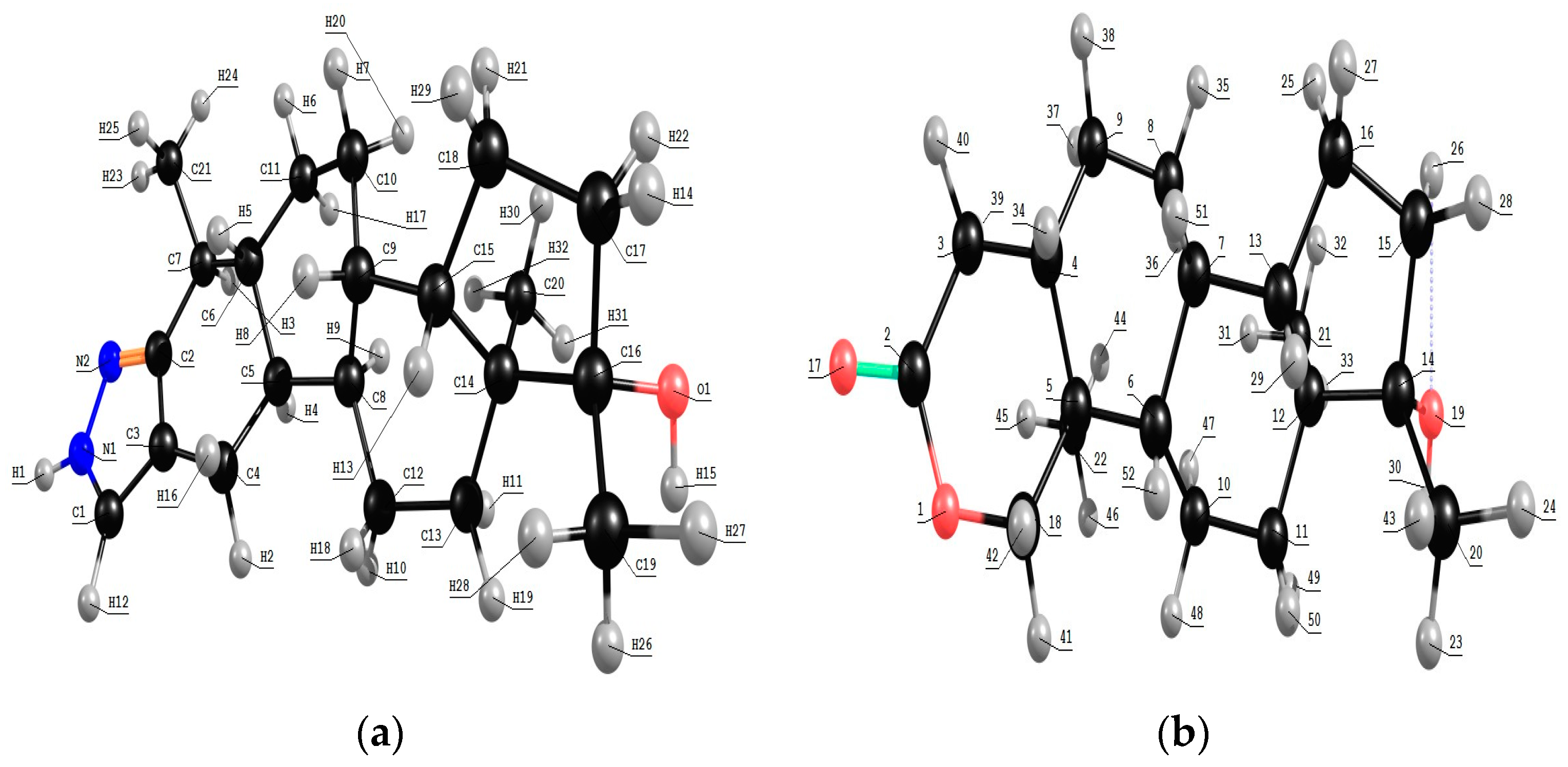
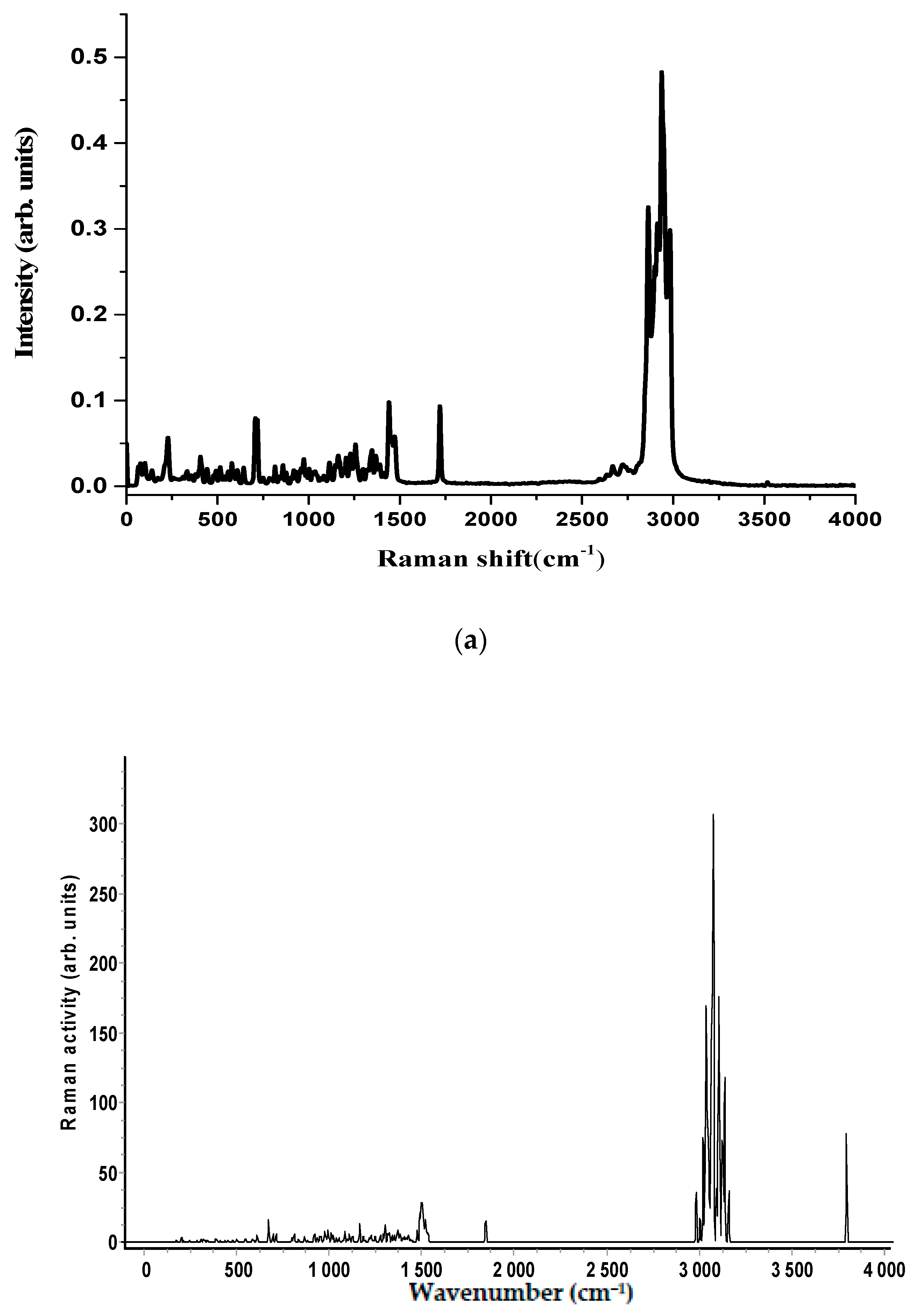

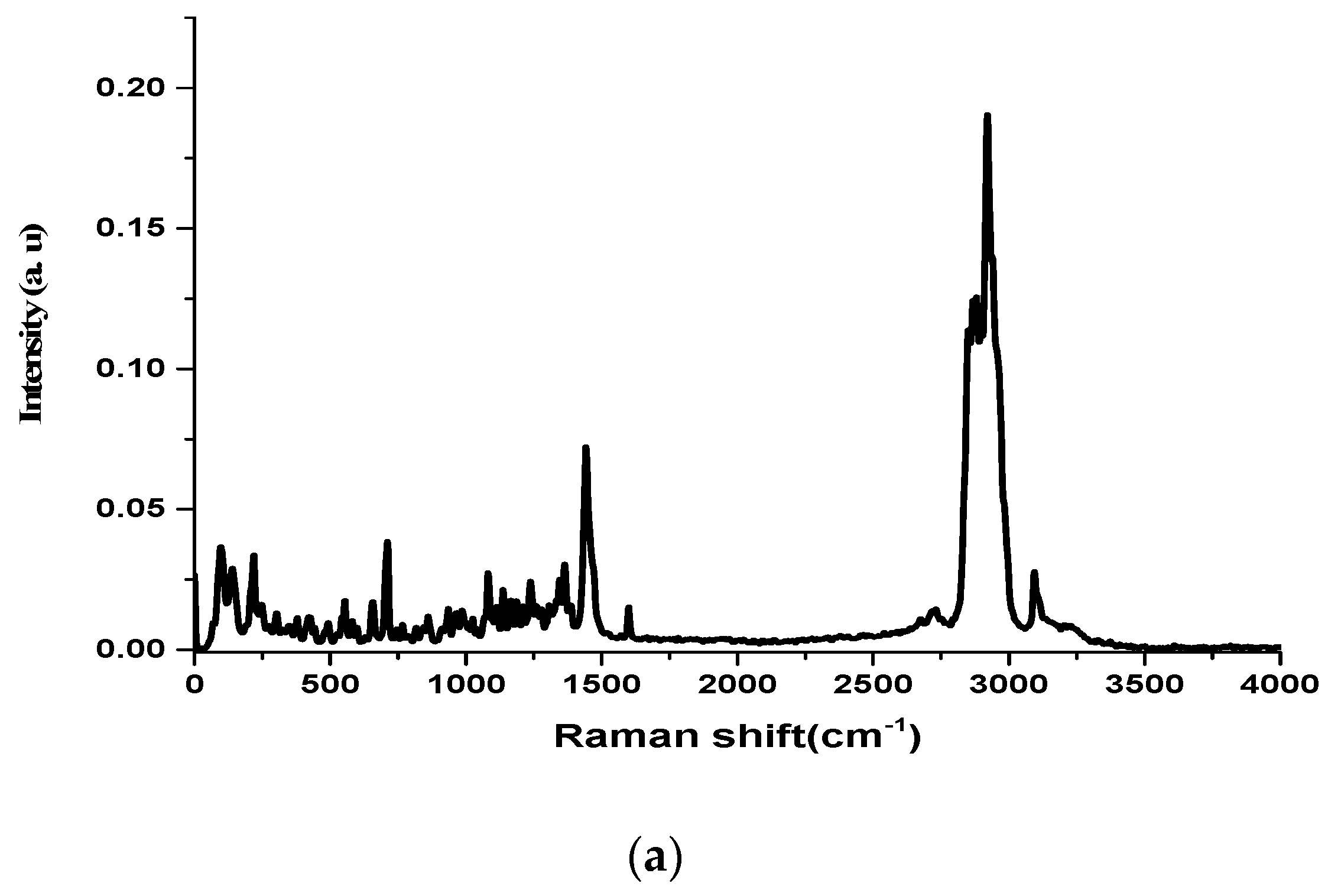
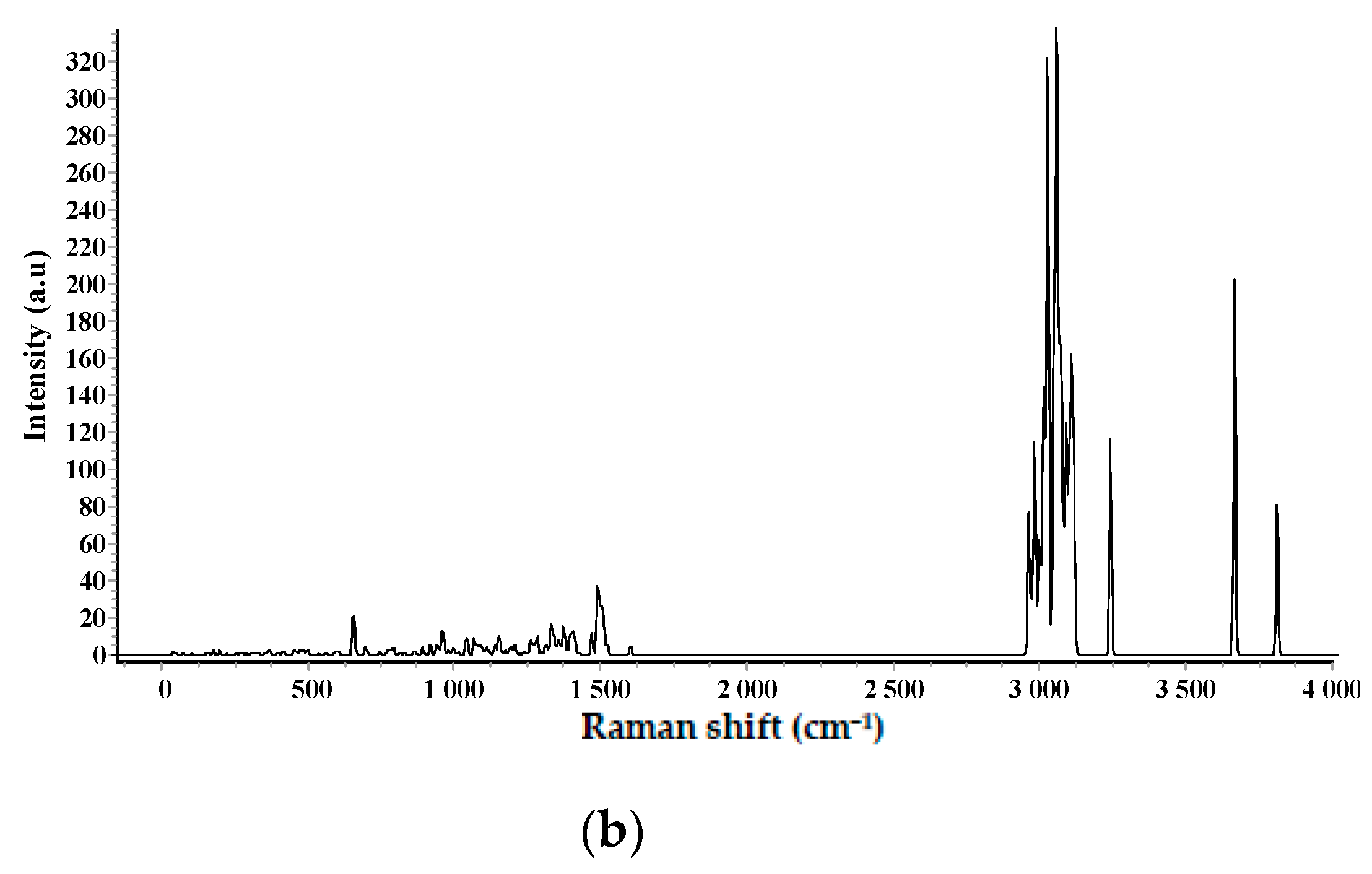
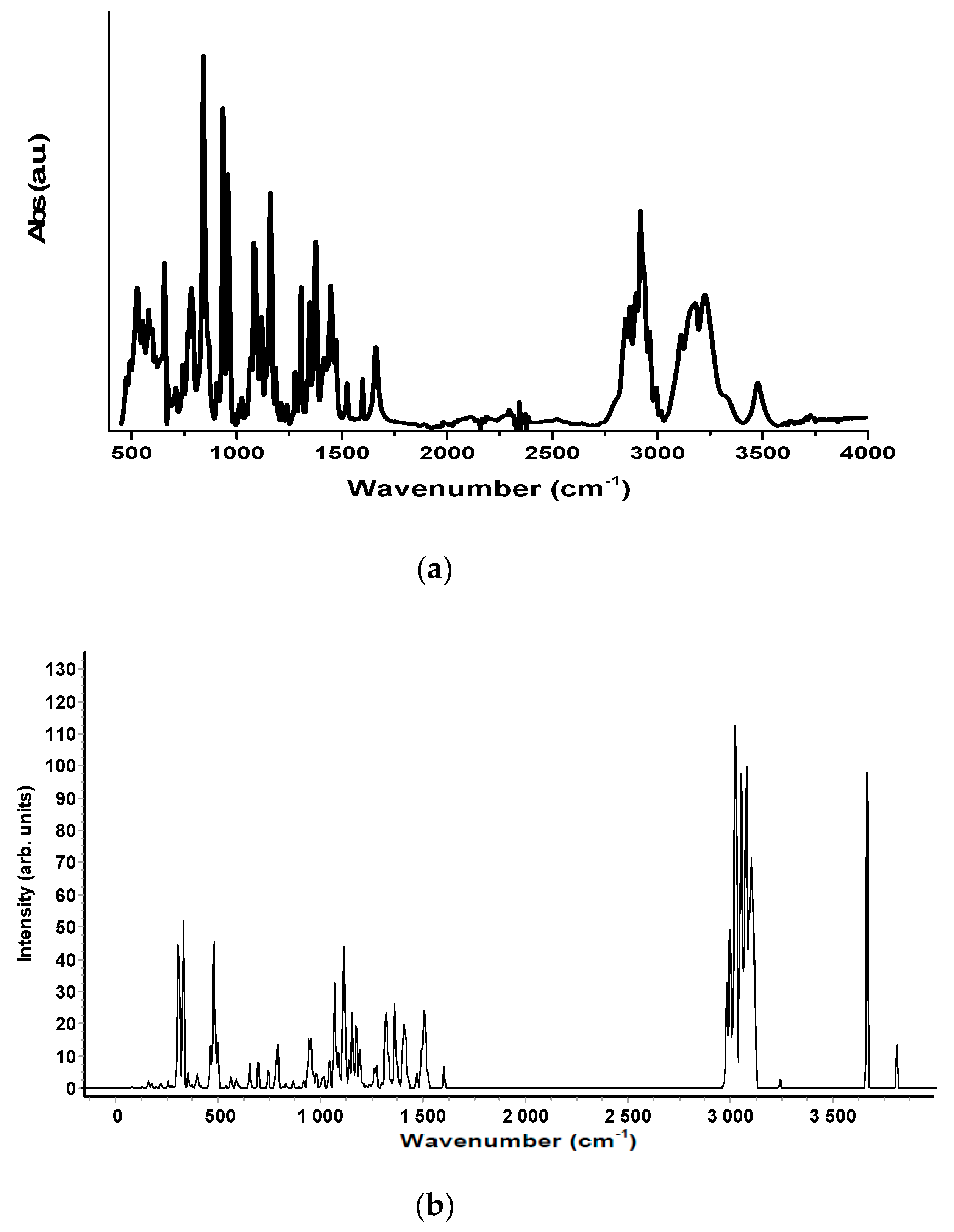
| Calculated a/cm−1 | IR Intensity b | Raman Activity c | Calculated d | Observed/(cm−1) IR | Observed/(cm−1) Raman | Assignments e |
|---|---|---|---|---|---|---|
| 3796 | 7.65 | 78.42 | 3649 | 3516 (0.44) | 3516 (0.01) | ν(OH) |
| 3423 (0.13) | 2 × 1720 = 3440 | |||||
| 3138 | 20.70 | 53.66 | 3017 | 2984 (0.26) | 2983 (0.62) | ν(CH)(CH3) |
| 3107 | 19.47 | 69.24 | 2987 | 2968 (0.28) | 2967 (0.48) | ν(CH)(CH3) |
| 1846 | 429.75 | 18.40 | 1775 | 1718 (0.99) | 1720 (0.19) | ν(C=O) |
| 1535 | 2.08 | 6.22 | 1476 | 1679 (0.23) | δ(HCH)(CH2)(CH3) | |
| 1529 | 3.96 | 5.14 | 1470 | 1473 (0.23) | 1472 (0.12) | δ(HCH)(CH2)(CH3) |
| 1523 | 3.02 | 6.27 | 1464 | 1466 (0.28) | δ(HCH)(CH2)(CH3) | |
| 1516 | 3.70 | 4.99 | 1457 | 1457 (0.12) | δ(HCH)(CH2)(CH3) | |
| 1508 | 1.60 | 10.79 | 1450 | 1450 (0.28) | δ(HCH)(CH2)(CH3) | |
| 1371 | 0.73 | 10.08 | 1318 | 1319 (0.15) | 1319 (0.04) | δ(HCH)(CH2)(CH3)(CH) + δ(COH) |
| 1352 | 0.68 | 0.70 | 1300 | 1299 (0.19) | 1298 (0.05) | δ(HCH)(CH2) + δ(COH) |
| 1252 | 2.63 | 2.38 | 1204 | 1203 (0.49) | 1204 (0.07) | δ(HCH)(CH2) + ν(CC) |
| 1238 | 120.76 | 1.17 | 1190 | 1188 (0.31) | 1190 (0.04) | ν(CO) + δ(HCH)(CH2) |
| 1217 | 57.05 | 2.99 | 1170 | 1171 (0.29) | 1169 (0.06) | ν(CO) + ν(CC) + δ(HCH)(CH2) |
| 1196 | 7.38 | 1.38 | 1150 | 1161 (0.37) | 1162 (0.07) | ν(CC) + ρ(CH3) |
| 1186 | 24.48 | 4.24 | 1140 | 1144 (0.17) | 1146 (0.05) | δ(HCH)(CH2) + ν(CC) |
| 1161 | 19.45 | 1.59 | 1116 | 1117 (0.19) | 1115 (0.06) | δ(HCH)(CH2) + ν(CC) + δ(COH) |
| 1128 | 17.42 | 1.78 | 1084 | 1091 (0.31) | 1092 (0.02) | ν(CC) + δ(HCH)(CH2) + δ(COH) |
| 1125 | 3.89 | 3.04 | 1081 | 1083 (0.24) | 1084 (0.03) | ν(CC) + δ(HCH)(CH2) |
| 1111 | 76.56 | 5.73 | 1068 | 1065 (0.37) | 1167 (0.02) | δ(COH) + ν(CC) +δ(HCH)(CH2) |
| 1086 | 30.68 | 6.06 | 1044 | 1047 (0.43) | 1046 (0.03) | ν(CC) + δ(CCC) |
| 1013 | 7.81 | 7.22 | 974 | 973 (0.25) | 973 (0.06) | ρ(CH2) |
| 1000 | 0.97 | 2.18 | 961 | 959 (0.04) | ν(CC) | |
| 994 | 1.822 | 9.12 | 956 | 952 (0.25) | 954 (0.04) | ν(CC) + ρ(CH2) |
| 976 | 3.17 | 5.60 | 938 | 931 (0.32) | 931 (0.04) | ρ(CH2) + ρ(CH3) |
| 958 | 9.10 | 3.68 | 921 | 919 (0.04) | ρ(CH3) + ν(CO) | |
| 951 | 14.78 | 4.27 | 914 | 905 (0.26) | 907 (0.02) | ρ(CH2) + ρ(CH3) |
| 868 | 1.32 | 4.00 | 834 | 838 (0.16) | 839 (0.02) | δ(CCC) |
| 835 | 4.53 | 2.21 | 803 | 815 (0.19) | 815 (0.05) | ρ(CH2) + ρ(CH3) + δ(CCC) |
| 813 | 5.80 | 5.32 | 782 | 798 (0.21) | 800 (0.02) | δ(CCC) |
| 807 | 0.96 | 2.18 | 776 | 786 (0.17) | 785 (0.02) | ρ(CH2) |
| 790 | 5.90 | 0.25 | 759 | 749 (0.19) | 750 (0.02) | δ(COC) + ρ(CH2) |
| 763 | 2.99 | 0.29 | 733 | 719 (0.23) | 719 (0.16) | δ(CCC) |
| 715 | 1.55 | 6.57 | 687 | 706 (0.16) | 707 (0.16) | δ(CCC) |
| 698 | 0.75 | 5.52 | 671 | 664 (0.00) | δ(CCC) | |
| 673 | 0.17 | 16.39 | 647 | 644 (0.17) | 644 (0.05) | δ(CCC) |
| 612 | 0.38 | 3.59 | 588 | 609 (0.30) | δ(CCC) | |
| 609 | 6.93 | 1.94 | 585 | 590 (0.16) | ρ(CH3) + δ(CCC) | |
| 594 | 0.87 | 1.29 | 571 | 578 (0.15) | 579 (0.06) | δ(CCC) |
| 587 | 8.05 | 1.53 | 564 | 556 (0.22) | 558 (0.04) | δ(CCC) |
| 550 | 2.43 | 2.14 | 529 | 549 (0.20) | 551 (0.02) | δ(CCC) |
| 543 | 0.27 | 0.58 | 522 | 530 (0.20) | 536 (0.02) | δ(CCC) |
| 537 | 2.41 | 0.40 | 516 | 515 (0.46) | 516 (0.05) | δ(CCC) |
| 503 | 1.83 | 1.57 | 484 | 491 (0.17) | 492 (0.04) | τ(CCCC) |
| Calculated a/cm−1 | IR Intensity b | Raman Activity c | Calculated d | Observed/(cm−1) IR | Observed/(cm−1) Raman | Assignments e |
|---|---|---|---|---|---|---|
| 3813 | 13.66 | 82.33 | 3665 | 3474 (0.19) | ν(OH) | |
| 3667 | 103.89 | 205.73 | 3525 | 3320 (0.19) | N—H | |
| 3243 | 2.53 | 116.64 | 3118 | 3014 (0.22) | ν(CH) | |
| 3114 | 19.63 | 78.08 | 2994 | 2996 (0.28) | 2992 (0.19) | ν(CH)(CH3) |
| 3048 | 14.58 | 40.76 | 2930 | 2929 (0.60) | ν(CH)(CH2) + ν(CH)(CH3) | |
| 3045 | 26.92 | 38.01 | 2927 | 2920 (0.72) | 2921 (0.95) | ν(CH)(CH2) + ν(CH)(CH3) |
| 3021 | 77.88 | 28.09 | 2904 | 2900 (0.50) | 2900 (0.58) | ν(CH)(CH2) |
| 2985 | 21.41 | 28.08 | 2870 | 2869 (0.45) | 2867 (0.63) | ν(CH)(CH2) |
| 2983 | 16.08 | 90.09 | 2868 | 2851 (0.59) | ν(CH)(CH2) | |
| 2973 | 3.90 | 27.18 | 2858 | 2848 (0.41) | 2849 0.60 | ν(CH)(CH2) |
| 1603 | 6.74 | 4.86 | 1541 | 1525 (0.12) | ν(C=N) + ν(C=C) | |
| 1524 | 5.51 | 5.13 | 1465 | 1471 (0.24) | 1469 (0.16) | δ(HCH)(CH2)sciss. |
| 1501 | 4.08 | 5.81 | 1443 | 1442 (0.28) | 1443 (0.38) | δ(HCH)(CH2)(CH3)sciss. |
| 1470 | 5.18 | 12.11 | 1413 | 1415 (0.20) | δ(N=NH) + ν(CC) | |
| 1427 | 3.79 | 0.78 | 1372 | 1381 (0.31) | 1387 (0.08) | δ(HCH)(CH3) |
| 1415 | 12.20 | 2.16 | 1361 | 1375 (0.49 ) | δ(HCH)(CH3) + δ(HCH)(CH2)twist. | |
| 1412 | 2.53 | 3.31 | 1357 | 1365 (0.16) | δ(HCH)wagg. + ν(C=N) + ν(C—C) | |
| 1400 | 0.71 | 6.08 | 1346 | 1347 (0.33) | 1346 (0.13) | δ(CCH) + δ(HCH)(CH2)twist. |
| 1394 | 0.51 | 7.33 | 1340 | 1335 (0.14) | 1333 (0.10) | δ(CCH) + δ(HCH)(CH2)wagg. |
| 1314 | 14.14 | 3.80 | 1264 | 1264 (0.06) | δ(HCH)(CH2)wagg. + δ(COH) | |
| 1260 | 5.62 | 5.00 | 1211 | 1210 (0.09) | 1210 (0.08) | δ(HCH)(CH2)twist, wagg. + ν(NN) + ν(CN) |
| 1191 | 11.38 | 4.05 | 1145 | 1142 (0.12) | ν(NN) +ν (CN) + δ(HCH)(CH2)twist. | |
| 1138 | 3.25 | 2.35 | 1094 | 1088 (0.51) | δ(CCC)ring + δ(HCH)(CH2)twist. | |
| 1120 | 26.80 | 1.31 | 1076 | 1081 (0.54) | 1083 (0.14) | ν(CC) + ρ(CH3) + ρ(CH2) |
| 1111 | 42.41 | 4.18 | 1068 | 1068 (0.25) | 1068 (0.06) | δ(COH) + ρ(CH2) + δ(CCC)ring |
| 1098 | 2.61 | 3.43 | 1055 | 1062 (0.22) | δ(COH) + ρ(CH2) | |
| 1088 | 8.58 | 4.35 | 1046 | 1042 (0.12) | 1042 (0.04) | ν(CC) + ρ(CH3) + δ(CCC)ring |
| 1076 | 9.69 | 3.01 | 1034 | 1026 (0.12) | 1025 (0.05) | ν(CC) + ρ(CH3) |
| 1068 | 32.86 | 9.10 | 1026 | 1012 (0.10) | 1013 (0.04) | δ(CNN) + δ(CCH/NCH) |
| 1040 | 3.15 | 4.03 | 1000 | 1001 (0.05) | 1001 (0.05) | ρ(CH3) + ρ(CH2) |
| 1006 | 2.94 | 0.42 | 967 | 986 (0.06) | 986 (0.07) | ν(CC) + δ(CCC) |
| 996 | 0.35 | 3.99 | 957 | 957 (0.68) | 963 (0.07) | ν(CC) + δ(CCC) |
| 980 | 4.77 | 2.62 | 942 | 934 (0.84) | 936 (0.08) | ρ(CH2) + δ(CCC) |
| 954 | 14.40 | 1.37 | 917 | 913 (0.12) | 912 (0.04) | ρ(CH3) + δ(NNC) |
| 919 | 2.34 | 5.63 | 883 | 868 (0.22) | 868 (0.04) | ρ(CH3) |
| 893 | 0.31 | 4.39 | 858 | 862 (0.07) | ρ(CH3) | |
| 868 | 2.25 | 0.94 | 834 | 841 (1.00) | 846 (0.05) | ρ(CH3) + ν(CC) |
| 862 | 0.31 | 1.41 | 829 | 816 (0.15) | 817 (0.04) | ρ(CH2) + δ(CCC) |
| 791 | 8.84 | 2.17 | 761 | 744 (0.16) | 746 (0.04) | ρ(CH) ↑ + ρ(CH2) |
| 604 | 0.33 | 1.10 | 581 | 591 (0.10) | τ(CCCC) | |
| 598 | 0.99 | 1.82 | 575 | 582 (0.16) | 582 (0.06) | τ(CCCC) |
| 538 | 0.77 | 0.42 | 517 | 527 (0.22) | 526 (0.03) | τ(CCCC) |
| 499 | 15.25 | 2.34 | 480 | 493 (0.08) | 493 (0.05) | τ(CCCC) + ρ(NH) ↑ |
© 2017 by the authors. Licensee MDPI, Basel, Switzerland. This article is an open access article distributed under the terms and conditions of the Creative Commons Attribution (CC BY) license (http://creativecommons.org/licenses/by/4.0/).
Share and Cite
Lemma, T.; De Barros Souza, F.; Tellez Soto, C.A.; Martin, A.A. An FT-Raman, FT-IR, and Quantum Chemical Investigation of Stanozolol and Oxandrolone. Biosensors 2018, 8, 2. https://doi.org/10.3390/bios8010002
Lemma T, De Barros Souza F, Tellez Soto CA, Martin AA. An FT-Raman, FT-IR, and Quantum Chemical Investigation of Stanozolol and Oxandrolone. Biosensors. 2018; 8(1):2. https://doi.org/10.3390/bios8010002
Chicago/Turabian StyleLemma, Tibebe, Fabiano De Barros Souza, Claudio A. Tellez Soto, and Airton A. Martin. 2018. "An FT-Raman, FT-IR, and Quantum Chemical Investigation of Stanozolol and Oxandrolone" Biosensors 8, no. 1: 2. https://doi.org/10.3390/bios8010002





